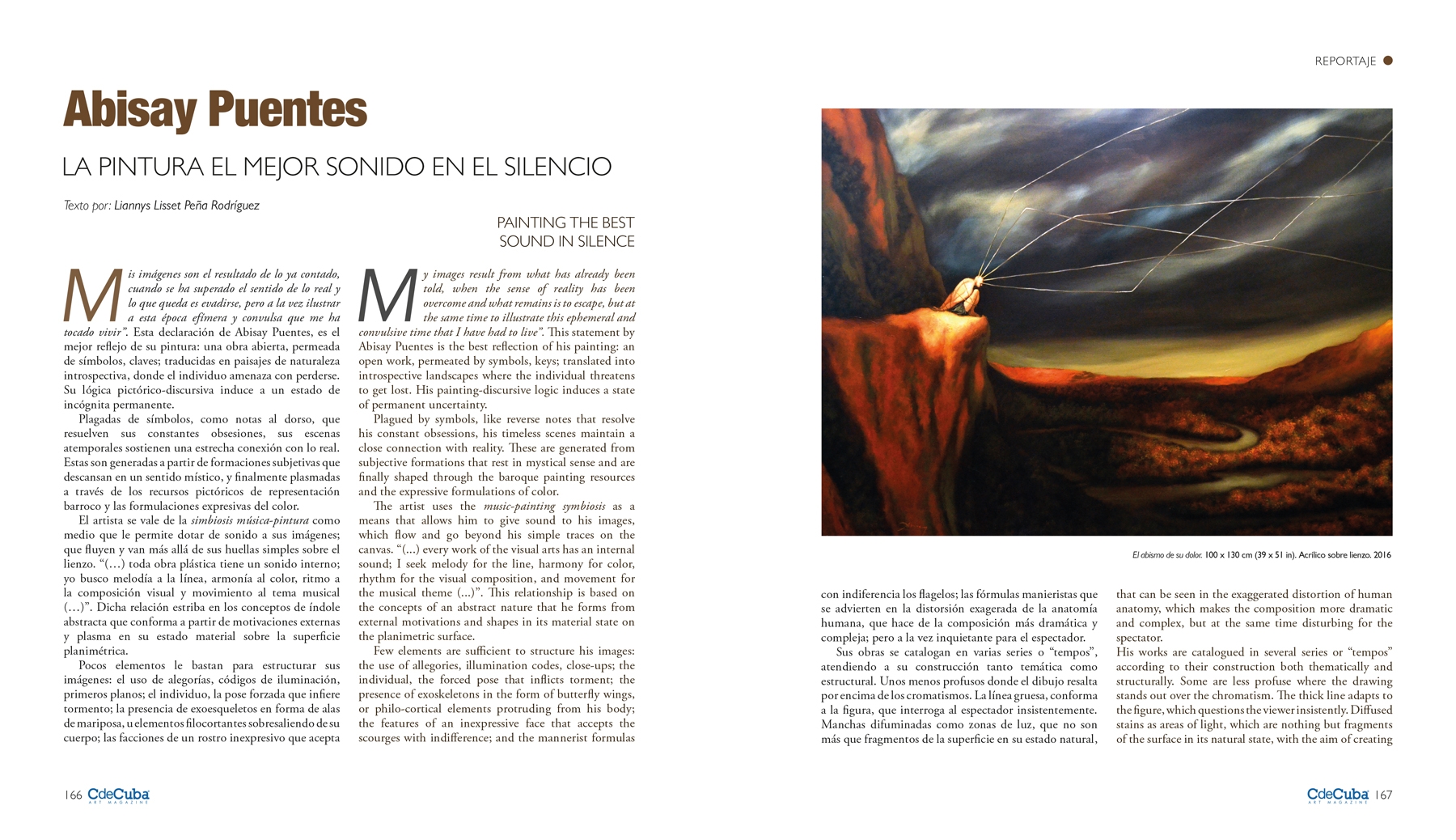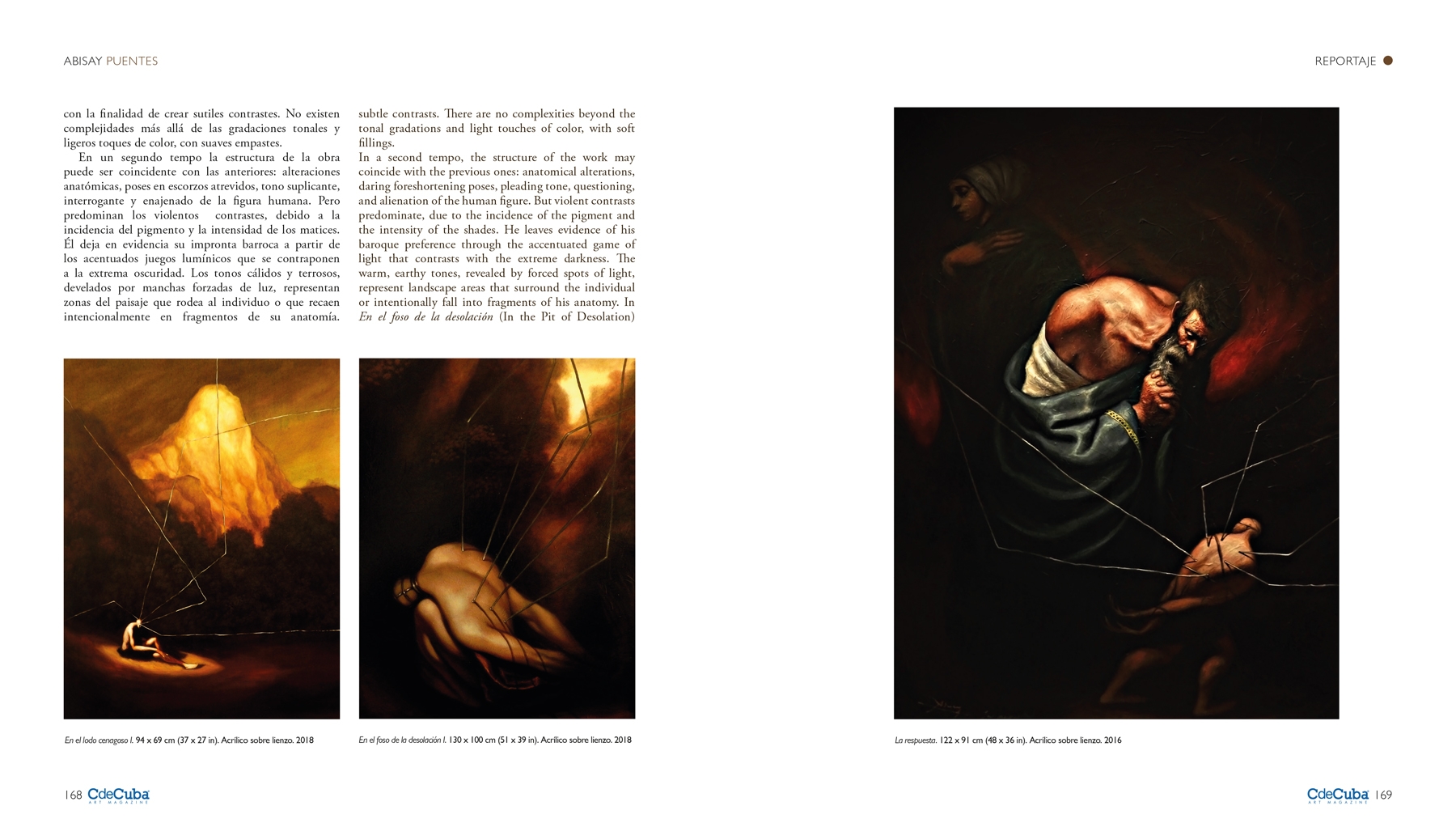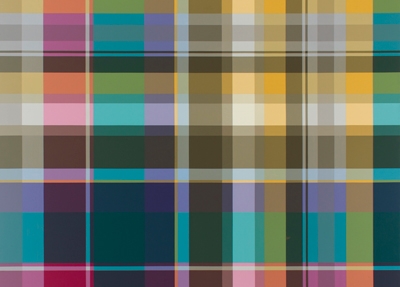Painting the Best Sound in Silence
By Liannys Lisset Peña Rodríguez
“My images result from what has already been told, when the sense of reality has been overcome and what remains is to escape, but at the same time to illustrate this ephemeral and convulsive time that I have had to live.” This statement by Abisay Puentes is the best reflection of his painting: an open work, permeated by symbols, keys; translated into introspective landscapes where the individual threatens to get lost. His painting-discursive logic induces a state of permanent uncertainty.
Plagued by symbols, like reverse notes that resolve his constant obsessions, his timeless scenes maintain a close connection with reality. These are generated from subjective formations that rest in mystical sense and are finally shaped through the baroque painting resources and the expressive formulations of color.
The artist uses the “music-painting symbiosis” as a means that allows him to give sound to his images, which flow and go beyond his simple traces on the canvas.“(…) every work of the visual arts has an internal sound; I seek melody for the line, harmony for color, rhythm for the visual composition, and movement for the musical theme (…)”. This relationship is based on the concepts of an abstract nature that he forms from external motivations and shapes in its material state on the planimetric surface.
Few elements are sufficient to structure his images: the use of allegories, illumination codes, close-ups; the individual, the forced pose that inflicts torment; the presence of exoskeletons in the form of butterfly wings, or philo-cortical elements protruding from his body; the features of an inexpressive face that accepts the scourges with indifference; and the mannerist formulas that can be seen in the exaggerated distortion of human anatomy, which makes the composition more dramatic and complex, but at the same time disturbing for the spectator.
His works are catalogued in several series or “tempos” according to their construction both thematically and structurally. Some are less profuse where the drawing stands out over the chromatism. The thick line adapts to the figure, which questions the viewer insistently. Diffused stains as areas of light, which are nothing but fragments of the surface in its natural state, with the aim of creating subtle contrasts. There are no complexities beyond the tonal gradations and light touches of color, with soft fillings.
In a second tempo, the structure of the work may coincide with the previous ones: anatomical alterations, daring foreshortening poses, pleading tone, questioning, and alienation of the human figure. But violent contrasts predominate, due to the incidence of the pigment and the intensity of the shades. He leaves evidence of his baroque preference through the accentuated game of light that contrasts with the extreme darkness. The warm, earthy tones, revealed by forced spots of light, represent landscape areas that surround the individual or intentionally fall into fragments of his anatomy. In En el foso de la desolación (In the Pit of Desolation) the awe surpasses us, the foreshortening of the figure denotes suffering and remains trapped in intense solitude; while in The Answer he shares the scene with Adam, who observes him, while Eve remains impassive in the background, almost nullified by the shadows. The light aggressively highlights parts of the face, hands, and clothing of the characters that occupy the main plane; theatrical features of the image that contribute to an internal rhythm within the composition.
The divine element permeates all compositions, but the spiritual sense takes on greater intensity where the human does not appear. It is these Brumas (Mist) in which everything is diluted, the third tempo. According to the artist it escapes all intellectual interpretation; it is a semi-figurative construct, which affects the subjective states of the observer, tending to exacerbate his introspection. This perennial stillness will have a disturbing rhythm with the representation of liquid surfaces in states of immobility, fogs in suspense and laconic landscapes of abstract hues.
Each scene is a “paradoxical plastic situation”(1) that defends the axiom of beauty in painting, even when its representations generate antagonisms. Lo bello y lo verdadero (The Beautiful and the True) seduces and surprises us; they share the same essence. His imagery is presented as a puzzle. These incomplete formulas are ordered according to the inspiration, knowledge and experience of the observer, allowing them to develop their own systems and access the different levels of complexity of visual language.
Spirituality is heard, read, and immediately perceived in them. It is an interwoven element in the way of living, acting and thinking of this artist. He is not interested in the representation of biblical passages; it would be, in addition to the structural distances, like a very particular warning Vanitas, metaphorized in that character, almost without face or voice; the future of a humanity that, according to many, is already destined to the scaffold.
Abisay is committed to painting as a mechanism for dialogue, which requires the constant updating of its forms. It is the instrument that allows him to embrace the universe of information that interests him and that he recognizes as valid. His work is timeless, it establishes connections with the past and the future, it is a legacy. As Kandisky would say, “Daughter of her time and mother of her own feelings” (2). His special way of talking about the soul of things and life.
1. Rodriguez, Belgium. Julio Larraz. Parallel Universes.
2. Kandinsky, Vasily, Of the Spiritual in Art. PREMIA editora S.A.






